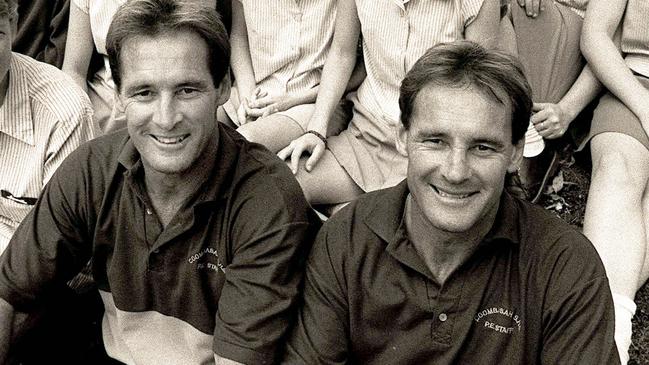Intolerable tolerance: Chris Dawson’s impunity reflects on carefree attitudes of the time
Chris Dawson was able to prey on a 16-year-old girl without fear, thanks to the negligent standards of the time.

In September 1979, as physical education teacher Christopher Dawson was running his pupils through health and fitness drills on the ovals of Cromer High School on Sydney’s northern beaches, a small, bespectacled public servant in Brisbane fitted a hose to the exhaust pipe of his car, fed it into the cabin, started the motor and gassed himself to death.
That man was Clarence Howard-Osborne, in his 50s, a court and parliamentary stenographer who lived an otherwise unremarkable life alone in his home in Mount Gravatt, just south of the Brisbane CBD.
Police attended the scene, and inside the house they found something remarkable – filing cabinets filled with index cards and more than 10,000 photographs of children he had molested. This innocuous shorthand expert was, in fact, a world-class pedophile.
That Howard-Osborne could conduct his private atrocities for more than three decades without being troubled by the attention of police remains, by today’s standards, beyond belief. His only punishment was death by his own hand.

Less than a year after Howard-Osborne’s demise, Dawson began preying on one of his own 16-year-old pupils in Sydney, a crime that took 43 years to arrive in a court of law. Watching him during this week’s verdict in Sydney’s District Court via audiovisual link from Long Bay Jail, where he is serving 24 years for the murder of his former wife, Lyn, you wondered how he could have flagrantly conducted sexual relations with a minor and not for a moment have been unsettled by the fact his actions were illegal.
At the time, did he not consider the consequences of his actions?
Let’s put his offending into context. While Dawson may not have come within a bull’s roar of the mind-boggling depravity of Howard-Osborne’s offending, the activities of both men, in their own way, benefited from the timbre of the times when it came to the judicial and indeed the community’s tolerance of such behaviour.
The 1970s marked the rise of civil libertarianism around the world. Groups such as PIE (Paedophile Information Exchange), established in 1975 in Britain, were determined to challenge the way society saw children and sexuality, advocating for the abolition of the age of consent.
And Australia had its own share of libertarians. (Howard-Osborne, it transpired, was linked to PIE.) Brisbane-based academic, criminologist and media commentator Paul Wilson met Howard-Osborne just before his suicide and would go on to write a book about him titled The Man They Called a Monster.

It was published in 1981, just as Dawson had solidified his relationship with his teenage pupil.
In it, Wilson wrote: “Many people, after reading the extracts from Osborne’s manuscript given in this book, will consider that this man was nothing more or less than a sexual pervert obsessed with the physical attributes of young males. To the young males, however, he was seen quite differently, being at various times a social support, a source for finding one’s identity, and a person who offered affection in an affectionless world.”
(Interestingly, a portrait of Dawson as a “social support” to his underaged female student lover was promoted during his carnal knowledge trial.)
Wilson went on: “I would abolish any age of consent in sexual relations on the basis that in my opinion it is both unjust and unworkable, and I would also repeal all legislation relating to the age of consent in the field of sexuality specifically. Instead, offences would be considered on the basis of the use of violence, force, fraud or pressure rather than an arbitrary age limitation.”
Just as the libertarians were fighting for their suspect beliefs in the ’70s and into the ’80s, there was intense debate in NSW about refreshing and reforming the state’s laws in relation to sexual assault.
While it’s not uncommon – this revision of legislation and how it applies to shifting community standards over time – the debate and resolution can take years. This was precisely what was happening in the ’70s and it would still be a point of debate when physical education teacher Dawson was having sexual intercourse with his student in the early ’80s.
A 1977 report titled Sentencing Sex Offenders in NSW by Ivan Potas, a senior legal research officer for the Australian Institute of Criminology, exposed some startling statistics in relation to penalties imposed on offenders found guilty of unlawful carnal knowledge with a girl aged between 10 and 16 years. The offence at the time attracted a maximum penalty of 10 years’ imprisonment.

The statistics highlighted a community attitude, as reflected by its system of crime and punishment, that today defies belief.
As Potas wrote, “during 1974 this (carnal knowledge) was the single most prevalent sexual offence tried by the higher courts. It was also the offence which earned the highest proportion of non-custodial dispositions.
“Thus, 142 offenders or 83 per cent of those tried in the Higher Courts received bonds, whilst only 12 offenders, or about 7 per cent, received prison sentences.”
The minuscule percentage of offenders receiving a custodial sentence for such a serious crime is almost inconceivable. A half-century on, it’s impossible to comprehend that a person found guilty of committing a sexual offence against a child would simply be given a bond and set free.
It took decades for Dawson to finally be punished for his actions. He was charged under the legislation that was in place when he committed his offence.
It was in 1980 that Dawson, according to the formal indictment against him, did “unlawfully and carnally know a girl above the age of 10 years and under the age of 17 years, namely 16 years and who was at the time a pupil of the said Christopher Michael Dawson”.
Dawson’s single charge – under the umbrella of section 73 of the Crime Act 1900 – was the result of the work of NSW Police Task Force Southwood, formed in the wake of the 2018 global smash-hit podcast The Teacher’s Pet, by The Australian’s Hedley Thomas.
Claims in the podcast by former students of Cromer High that teachers were conducting sexual and inappropriate relationships with students triggered the NSW Child Abuse and Sex Crimes Squad to form Southwood.

In 2020 Task Force Southwood charged another northern beaches teacher with sexually abusing a teenage girl between 1978 and 1980. Lee Joyce Dunbar, a physical education teacher at Beacon Hill High School at the time of the alleged abuse, was due to go to trial in the NSW District Court late last year but entered a plea of guilty to one charge of indecent assault.
Dunbar’s victim gave the court harrowing details of the abuse at the hands of her teacher. She said Dunbar, who was 26 at the time of the offences, hid behind her position of trust as a teacher, gave her false friendship, groomed her and abused her from when she was 16.
Dunbar, in her late 60s, from Five Dock in Sydney, was sentenced to 18 months, to be served through a corrections order in the community.
Dawson himself faces a maximum penalty of 14 years in prison. He has yet to complete the first year of his 24-year sentence imposed by Justice Ian Harrison late last year for murder.
When Dawson was found guilty this week of carnal knowledge, he let loose a string of expletives under his breath and was returned to his cell at Long Bay.
Courtesy of the trial’s evidence over a few weeks, he was taken back to those carefree days in the ’70s and into the ’80s when, as a married man and father of two small daughters, he could hold the hand of his teenage student lover in the schoolyard without batting an eyelid. He could cavort and canoodle with her in his school office and be caught doing so without fear of consequence from school authorities. He could drop love notes into his teenage lover’s school bag, himself as giddy as a schoolboy.

As one Cromer student, who declined to be named, said of those winsome school days: “It felt like the teachers and the students, especially the girls were like friends, you know, like there was no differentiation. There was no discipline. You know, you could leave the classroom if you wanted. There was no real figurehead, even like higher up, like the principal and the deputy principal … it was a friendship group in a way.
“And it was sort of like that because it was a beaches thing too. We’d see the teachers at the beach, you know, on the weekends. And then if we decided to go down to the pub or something, even though you’re not supposed to, all the teachers are at the pub you know, at the Time and Tide.
“I don’t remember ever really thinking of my teachers as people that I thought of as like … authority figures.”
In the end, there remained one chasmic difference between the Brisbane monster, Howard-Osborne, and Dawson. While they both seemed to share a casual indifference to the law at the time of their offences, Howard-Osborne saw the writing on the wall.
He was spoken to by police after a mother reported him photographing her son in a local park. By the next morning he was dead.
(In 2016 his biographer, Wilson, would himself be found guilty of four counts of indecent treatment of a child under the age of 12 – the charges stemming back to the ’70s. He was sentenced to 18 months in prison.)
Dawson, however, never seemed to appreciate that one day he might have to take responsibility for his actions. It was there in his rear-vision mirror all along. But he never noticed it.
IT’S BACK: The podcast investigation that caught a child abuser and killer.
Hear Hedley Thomas’s global smash hit podcast The Teacher’s Pet. Available now wherever you get your podcasts








To join the conversation, please log in. Don't have an account? Register
Join the conversation, you are commenting as Logout